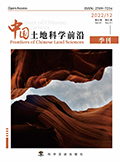

土地利用空间分布规律对区域资源管理具有重要科学价值。以滨海区县曹妃甸区为对象, 基于其临海盐田、湿地等独特地理特征, 开展土地利用现状分类与格局分析。研究构建“一级整体分类—二级细分类”的分层分类体系, 其中以Landsat遥感影像为数据源, 运用随机森林、支持向量机、基于样本的面向对象3种机器学习算法进行一级土地利用提取, 进一步通过OSM样本集优化预处理, 实现盐田、湿地等特色二级土地利用划分。精度验证结果表明, 一级土地利用分类中, 基于样本的面向对象提取方法表现最优, 总体精度为85. 58% (Kappa 0. 79) , 空间格局呈现“农用地和建设用地占主导, 水体、未利用地和湿地并存”的特征; 二级土地利用细分结果, 呈现“水田和河 流水面占主导, 城镇村道路用地规模性聚集”的格局, 其中特色地类设施农用地分类精度最高为93. 22%, 盐田为85. 63%, 随机森林算法对具有明显特征的地类识别能力较好, 但对光谱、形状相似的地类 (如盐田周边土埂与道路) 识别能力较差。研究不仅可以为曹妃甸土地资源配置提供数据支撑, 还为滨海区域的土地利用分类研究提供参考。
The spatial distribution pattern of land use holds significant scientific value for regional resource management. Taking Caofeidian District, a coastal county, as the research object, this study conducts classification and pattern analysis of current land use status based on its unique geographical features such as coastal salt pans and wetlands. A hierarchical classification system of “first-level overall classification and second-level detailed classification” is constructed. Using Landsat remote sensing images as the data source, three machine learning algorithms—random forest, support vector machine, and sample-based object- oriented method—are applied for first-level land use extraction. Further, through preprocessing optimization with the OSM sample set, the classification of characteristic second-level land uses such as salt pans and wetlands is realized. The accuracy verification results show that in the first-level land use classification, the sample-based object-oriented extraction method performs the best, with an overall accuracy of 85. 58% (Kappa 0. 79) . The spatial pattern is characterized by “agricultural land and construction land as the dominant types, coexisting with water bodies, unused land, and wetlands”. The second-level land use classification results reveal a pattern of “paddy fields and river surfaces as the main types, with large-scale aggregation of urban, rural, and road land”. Among them, the classification accuracy of characteristic land types such as facility agricultural land is the highest at 93. 22%, and that of salt pans is 85. 63%. The random forest algorithm shows good recognition ability for land types with obvious features but poor performance in identifying land types with similar spectra and shapes (e. g. , ridges around salt pans and roads) . The above research can not only provide data support for land resource allocation in Caofeidian but also provides reference for land use classification research in coastal areas.